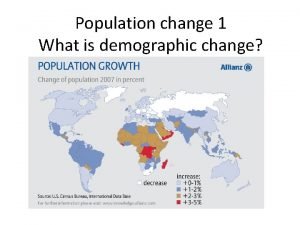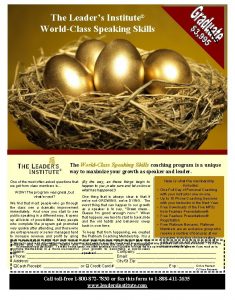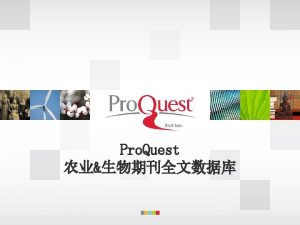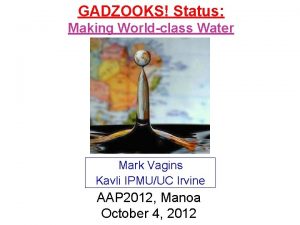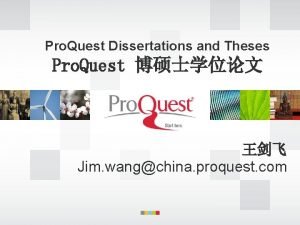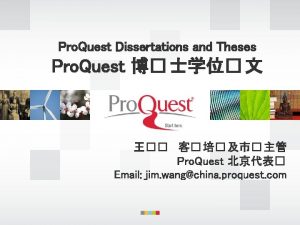The Quest for Worldclass Status Challenges and Prospects



























- Slides: 27

The Quest for World-class Status: Challenges and Prospects for HE in Asia Professor Ka Ho Mok Vice President and Chair Professor of Comparative Policy Lingnan University, Hong Kong

Lingnan University Top 10 Liberal Arts Colleges in Asia (Forbes, 2015)

Contents: u Major HE Development Trends • Massification of HE • The Quest for “World-class” Status and Impact on University Governance • Challenges for Labor Market and Employment u Implications for Education Equality/Quality and Repurposing University Education u Implications for UK Universities

Massification of HE Ø The development of higher education (HE) in most Asian countries during the last two decades is a remarkable success story. Recognizing HE is an important ingredient in the economic and social development of their country, the governments in this region offer strong support to meet the enormous need for highly skilled technical, professional, and managerial leaders. Ø The HE systems has changed from elite to massification and even to post-massification in the Asia-Pacific region like their western counterparts since 1980 s (Hawkins, Mok & Neubauer, 2014).

Figure 1 Expansion of HE by Region (Indicated by Gross Enrolment Rate) (1999 -2013) 90 80 70 60 50 40 30 20 10 0 1999 2000 2001 2002 2003 2004 2005 2006 2007 2008 2009 2010 World Arab States Central and Eastern Europe Central Asia East Asia and the Pacific Latin America and the Caribbean North America and Western Europe South and West Asia Sub-Saharan Africa 2011 2012 2013 Source: United Nations Educational, Scientific, and Cultural Organization (UNESCO) Database, retrieved from http: //data. uis. unesco. org

Figure 2 Expansion of HE Enrolment Rate in Selected Asian Countries/Areas (1999 -2013) 100 80 60 40 20 0 1999 2000 2001 2002 South Korea 2003 2004 Taiwan 2005 Japan 2006 2007 Hong Kong 2008 2009 2010 Mainland China 2011 World Source: UNESCO Data Base. Retrieved from http: //data. uis. unesco. org/. 2012 2013

Massification of HE Ø • • Specifically in China as an Instance: In 1996, only 4 per cent of the 18 - 22 -year-old cohort in China (equally about 3 million students) attended post-secondary institutions, but this figure rose to 24 per cent (equally 27 million students) by 2009 (Carnoy, et al. , 2013, p. 48). The number of students enrolled in minban colleges jumped from 222, 32 in 1997 to 557, 520 in 2013 (China Statistical Yearboooks and Yearbooks of Ministry of Education, 20022014).

Figure 3 Changes in Number of Minban Colleges (Excluded Independent Colleges) 500 450 400 350 300 250 200 150 100 50 0 2002 2003 2004 2005 2006 2007 2008 2009 2010 2011 2012 2013 Sources: Revised and adjusted based on China Statistical Yearbook (2002 -2014), National Bureau of Statistics of China, and Educational Statistics Yearbook of China (2002 -2014), Ministry of Education (China).

Massification of HE Ø • Concerns: The rapid expansion of HE in Asia without careful mapping of graduate employment and changing labour market needs, may create problem for to graduate unemployment and insufficient upward social mobility.

The Quest for “World-class” Status and Impact on University Governance Ø Universities in East Asia are increasingly under pressures to compete internationally. Interest in university league tables has become the norm, not only in the UK and Canada, but also in Hong Kong, Singapore, Malaysia, Thailand, Vietnam, Taiwan and Mainland China (Altbach, 2010; Chan, 2015; Liu & Cheng, 2005; Mok & Hawkins, 2010). n Hong Kong: Great Emphasis on Research Performance Research-led funding (Mok & Cheung, 2011). For government: Several rounds of Research Assessment Exercises (RAEs) since the 1990 s. For universities: differentiating roles; identifying specific strengths; developing centres of research excellence. For academic staff: international research; high quality teaching; professional and community services. • •

The Quest for “World-class” Status and Impact on University Governance n • • Taiwan: Two Key Policy Targets At least one Taiwanese university ranked in the top 100 universities in the world, And at least 15 key departments or cross-university research centres ranked among the top in Asia within the next five years (Lu, 2004). Strategy and Consequences: The “Programme for Promoting Academic Excellence of Universities” Increasing attention to University league tables (Lo & Chan, 2006; Lo & Weng, 2005; Research Institute of HE and University Evaluation, 2005). Growing importance attached to international publication (Chen & Lo, 2007). Stratification of universities (Chou, 2012).

The Quest for “World-class” Status and Impact on University Governance Ø • • • China: “ 211 Project” and the “ 985 Scheme”. Enable selected HE institutions to become “world class universities”. “ 211 Project”: to develop 100 key universities and disciplines through targeted supplementary funding aimed at improving the quality of teaching and research facilities. “ 985 Scheme”: to transform China’s most elite universities (i. e. , Beijing University (Peking University) and Tsinghua University) to the super-elite of the world class universities.

The Quest for “World-class” Status and Impact on University Governance Ø • • Ø • Japan: Flagship Universities Project Aim to developing a few major Japanese universities into “world class universities”. Reposition Japanese universities in the rapidly changing global environment. Allocate additional resources to promote internationalization. New initiatives to support international collaboration and student exchange (Furushiro, 2006; Yonezawa, 2007). Concerns: These policies may intensify differentiation among Japan’s universities.

The Quest for “World-class” Status and Impact on University Governance Ø • • l • • • Singapore and Malaysia: Identify major global universities and invite them to set up their branch campuses in the city-state. Attempt to attract leading academics to collaborate with local scholars (Gopinathan & Lee, 2011; Mok & Tan, 2004). Similar situations can be found in other Southeast Asian societies like Malaysia: Restructuring the university system along the lines of “neo-liberalism” Make Malaysia a regional hub of HE. More overseas academics appointed to the system and international collaborations with overseas institutions in terms of research and teaching has received strong support from the state (Mok, 2007).

Table 1 Different Schemes in Promoting World-class Universities Country/Region Project China Japan “ 985” and “ 211”project Flagship Universities Project; “Global 30” Scheme; Competitive Funding Allocation Method (the 21 st Century Centres of Excellence; the Global Centres of Excellence; the World Premier International Research Centre Initiative) Brain Korea 21; World-Class University Initiative and the BK 21 Plus Project South Korea Taiwan Singapore Hong Kong Programme for Promoting Academic Excellence of Universities; Five Year – 5 billion Excellence Initiative; Development Plan for World-class Universities and Research Centres for Excellence “World-Class Universities” Programme Comprehensive Education Reviews; Role Differentiation Exercise; Positioning Hong Kong as International Key Player in HE; University Merging and Deep Collaboration; Research Assessment Exercises; Teaching and Learning Quality Process Reviews; Management Reviews and University Governance Review Source: Cheng, Y. , Wang, Q. , & Liu, N. C. , 2014; Mok, 2005.

The Quest for “World-class” Status and Impact on University Governance Ø The results of these efforts to quest for world-class status are evident by in recent international university benchmarking exercises. • Times HE University Rankings (2015 -2016): nine out the top 10 universities in Asia ranked among the top 100 universities in the world. Five of them featured among the top 50 in the world –National University of Singapore (26), Peking University (42), University of Tokyo (43), University of Hong Kong (44) and Tsinghua University (47). QS World University Rankings: Asian universities maintain a relatively high ranking as ranked Top 100 in the world between 2010 to 2015. Shanghai Jiaotong Academic Ranking: the rise of Asian universities in the global university league in the last couple of years. • •

Table 2 The Increase of Asian Universities Ranked Top 100 in QS and Times University League (2010 -2015) 2010 2011 2012 2013 2014 2015 QS NA NA 19 17 17 19 Times 10 9 11 11 11 9 Source: QS World University Rankings (2011 -2015). Retrieved from http: //www. topuniversities. com/qs-world-university-rankings; Times HE World University Rankings (2010 -2015), Retrieve from https: //www. timeshighereducation. com/world-university-rankings/2016/worldranking#!/page/0/length/25

Figure 4 The Increase in Number of Asian Universities Ranked in Shanghai Jiaotong Academic Ranking 80 75 75 71 70 70 71 72 76 74 [VALUE] 72 [VALUE] 65 65 61 60 55 64 2003 2004 2005 2006 2007 2008 2009 2010 2011 2012 2013 2014 2015 Source: Shanghai Jiaotong Academic Ranking of World Universities (2003 -2015), retrieved from http: //www. shanghairanking. cn/ARWU 2015. html

Table 3 Continents contributing to HE Policy (1988– 2013) (percentage between brackets) Continent 1988– 1992 1993– 1997 1998– 2002 2003– 2007 2008– Total Australasia 6 (3) 22 (9) 18 (9) 17 (8) 25 (8) 88 (8) Europe 102 (44) 81 (33) 87 (45) 88 (43) 153 (51) 511 (44) North America 48 (21) 52 (21) 42 (22) 47 (23) 52 (17) 241 (21) Asia 35 (15) 46 (19) 26 (13) 33 (16) 50 (17) 190 (16) Latin America 18 (8) 16 (7) 10 (5) 3 (1) 2 (1) 49 (4) Africa 18 (8) 27 (11) 12 (6) 16 (8) 17 (6) 90 (8) Unknown 3 (1) Source: Huisman, J. , 2013. Retrieved from journals. com/hep/journal/v 26/n 4/full/hep 201330 a. html 3 (<1) http: //www. palgrave-

Challenges for Labour Market and Employment � • • The rapid expansion of HE led to issues regarding academic standards and quality of universities in mainland China, Taiwan, South Korea, and Japan (Mok, 2013), and resulted in graduate unemployment and underemployment in East Asia. South Korea: 3 million economically inactive graduates; Japan: approximately 38 per cent of Japanese graduates were unemployed eight months after graduation in 2009 and graduate employment has not improved; India: one in three young graduates is unemployed; China: in 2013 alone only 38 per cent of graduates were issued contracts, with contracts being an indicator of quality jobs (Lauder, 2014).

Table 4 Youth Unemployment in East Asia (selected countries) Country/ Area China (mainland) Unemployment Rate Undergraduate 17. 6% (two months after graduation) Undergraduates from Rural Areas 30. 5% Hong Kong Youth Unemployment Rate (15 -24) 9. 1% Associate Degree 5. 8% Undergraduate 3. 8% Master or Above 4. 2% Taiwan Junior High School 3. 53% Senior High School 4. 11% Junior College 3. 11% Undergraduate 5. 81% Postgraduates 3. 29% Singapore Degree holders 2. 8% Graduates with Diploma and Professional Qualifications 2. 7% Students below-secondary 2. 4% South Korea Youth Unemployment Rate (under 30 s) 8. 3% Source: China (mainland): My. COS Data, 2013; Hong Kong: retrieved from http: //news. takungpao. com. hk/hkol/education/2013 -06/1687142. html; Taiwan: retrieved from http: //www. edu. tw/pages/detail. aspx? Node=4076&Page=20047&Index=5&WID=31 d 75 a 44 -efff-4 c 44 -a 075 -15 a 9 eb 7 aecdf ; Singapore: retrieved from http: //www. straitstimes. com/news/opinion/more-opinion-stories/story/growing-concerns-over-graduate-employment-20140905 ; South Korea: Park, 2013, p. 17.

Challenges for Labour Market and Employment Ø • • • Questioned Role of Education in Upward Social Mobility: A degree does not assure employment, high earnings, and upward social mobility. Haveman and Smeeding (2006) showed the growing income-related gap both in access to and in success in HE in America. In top-tier colleges and universities, almost three quarters of the entering class is from the highest socio-economic quartile. Similar developments can be found in other parts of Asia. The unintended consequence comes with the growing pressure for creating more job opportunity with high-skilled labour with lower economic returns simply of the over-supply of talents under the context of the Global Auction (Brown et al. , 2011).

Implications for Education Equality / Quality and Repurposing University Education Ø • • • The massive expansion of HE has not promoted equality in education but further intensified education inequality in Asia, particularly in China. “The majority of the enrollment growth in coming years will be in two countries, China and India, both of which have massive populations, but both of which also are characterized by very significant patterns of income and social inequality, a characteristic both within urban populations but especially existing between urban and rural populations” (Neubauer & Hawkins, 2014, p. 3). Families with children and from lower socio-economic status in Hong Kong have suffered most from the privatization of education (Mok, 2015). Young adults from middle- or upper-class families enjoy far more HE opportunities (nearly threefold) than those from relatively low-income groups (Chou, 2013).

Implications for Education Equality / Quality and Repurposing University Education Ø In short, the massification and privatization of HE have resulted in highly complicated graduate employment and social mobility problems currently confronted by the youth. Therefore, student movements in Europe and Asia, in which anxieties and angers are expressed against the ruling regimes, are unsurprisingly widespread. Ø All the issues discussed above have inevitably affected the academic profession. The rapid expansion of HE in Asia implies that teaching and research is carried out by staff that is less qualified, overworked with heavy teaching load, has to teach large classes, is paid low salaries, and is given little opportunity to provide personal attention to students.

Implications for Education Equality / Quality and Repurposing University Education Ø Ø • • Asia should be congratulated for its efforts to improve standards in HE, but we should not drive reforms to make changes without placing equally important emphasis on universities achieving excellence holistically (Mok & Nelson, 2013). Bring back the humanistic perspective in university governance and transformation is urgently needed. Academics and administrators in Asian HE systems should shift attention toward the quest for excellence not only for efficiency and economic gains but also for human wellbeing enhancement. Questing for “Excellence with a Soul” should become the core business of the Asian academic community; Rediscover and reinvent the Asian values and traditions to make Asian universities preferred institutions for nurturing caring leaders with global vision and regional perspectives.

Implications for UK Universities Ø Ø Ø Ø Ø The rise of Asia in research grants and opportunities and opportunity for international cooperation; The growth of quality students from Asia and implications for student admissions and immigration policies; The increase in choices for students from Asia for overseas studies destination and implications for international HE; The keen interest in developing transnational HE (dual or joint degrees and jointventure) in Asia and opportunity for UK universities; The growing research capacity of Asian scholars and the intensification of competition for UK institutions; The call for internationalization of HE in Asia and opportunity for UK institutions; The rise of Asian universities in global university leagues and implications for UK institutions; The Chinese government’s recent reforms in vocational HE and opportunity for UK institutions; The growing interest in developing Liberal Arts Universities and implications for humanities and social sciences disciplines.

Thank you!
 Quantum computing progress and prospects
Quantum computing progress and prospects The phrase elysian prospects suggests the
The phrase elysian prospects suggests the Prospects of agriculture in bangladesh
Prospects of agriculture in bangladesh World population prospects
World population prospects Prospects preposition
Prospects preposition Kontinuitetshantering i praktiken
Kontinuitetshantering i praktiken Typiska novell drag
Typiska novell drag Nationell inriktning för artificiell intelligens
Nationell inriktning för artificiell intelligens Ekologiskt fotavtryck
Ekologiskt fotavtryck Varför kallas perioden 1918-1939 för mellankrigstiden
Varför kallas perioden 1918-1939 för mellankrigstiden En lathund för arbete med kontinuitetshantering
En lathund för arbete med kontinuitetshantering Kassaregister ideell förening
Kassaregister ideell förening Tidbok yrkesförare
Tidbok yrkesförare A gastrica
A gastrica Densitet vatten
Densitet vatten Datorkunskap för nybörjare
Datorkunskap för nybörjare Stig kerman
Stig kerman Debattartikel struktur
Debattartikel struktur För och nackdelar med firo
För och nackdelar med firo Nyckelkompetenser för livslångt lärande
Nyckelkompetenser för livslångt lärande Påbyggnader för flakfordon
Påbyggnader för flakfordon Kraft per area
Kraft per area Svenskt ramverk för digital samverkan
Svenskt ramverk för digital samverkan Urban torhamn
Urban torhamn Presentera för publik crossboss
Presentera för publik crossboss Jiddisch
Jiddisch Plats för toran ark
Plats för toran ark Klassificeringsstruktur för kommunala verksamheter
Klassificeringsstruktur för kommunala verksamheter



